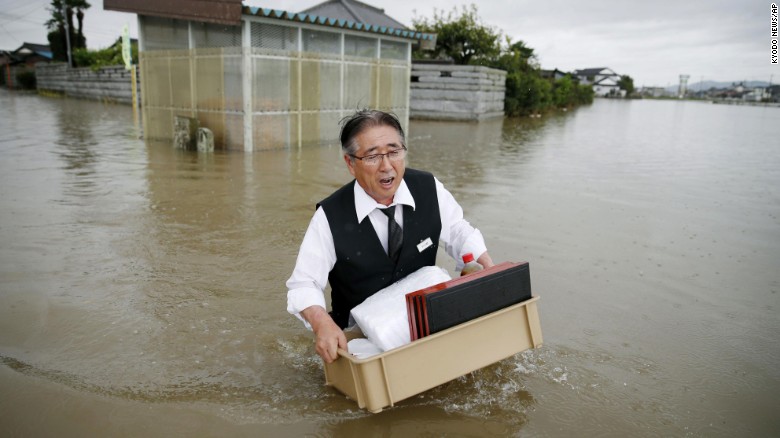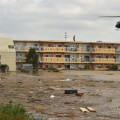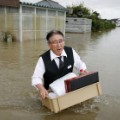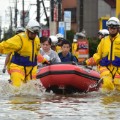Japan flooding: 3 deaths, levee breaks, many missing
In the latest area to suffer from extreme flooding caused by a lingering rainy season and compounded by a tropical storm, rescue teams in Osaki City, in the northeastern prefecture of Misaki, are battling to save residents after a section of a levee containing the Shibui River broke early Friday morning.
Around 100 buildings in the city have been flooded, prompting calls from residents to the city government and emergency services for aid.
As many as 1,000 people live in the affected area, the city's disaster prevention office told CNN Friday, but the office could not confirm how many were seeking rescue. More than 700 Osaki residents have been temporarily placed in shelters according to NHK, Japan's state media.
Rescue workers including firefighters and members of Japan's Ground Self-Defense Force (GSDF) were using boats and helicopters to reach residents. The disaster prevention office said that 115 people had been rescued as of 2.50 p.m. Friday (1:50 a.m. Friday ET).
Heavy flooding causes deaths, injuries
Heavy flooding over eastern Japan has caused three deaths, almost two dozen unaccounted for and houses washed away as residents were forced to their rooftops, desperate for rescue by military helicopters.
In Miyagi Prefecture, one woman was found dead in her floating car, and in Tochigi Prefecture, to the north of the capital Tokyo, two deaths were reported, one in a landslide and another who had drowned.
At least 28 people are injured across 10 prefectures in Japan, police say, and at least 22 people have been reported missing since floods inundated parts of eastern Japan.
Japan's Yomiuri Shimbun newspaper cited authorities in reporting the landslide death of a 63-year-old woman in Kanuma, Tochigi Prefecture.
The raging brown floodwaters spawned from Tropical Storm Etau, which has dumped 60 centimeters (2 feet) of rain over some areas since Monday.
Combine that with several weeks of near-daily rainfall, and swaths of eastern Japan are now deluged.
"Tochigi Prefecture is facing a grave danger and is in an emergency situation," Japan Meteorological Agency Spokesman Takuya Deshimaru said Thursday. "It is experiencing unprecedented downpour."
Joso: At the heart of the floods
At daybreak Friday in the city of Joso, Ibaraki Prefecture, CNN saw Japan Self-Defense Force (SDF) helicopters land on the roof of a shopping center where dozens of people had been stranded overnight.
In a rare break from the almost-daily rains, a hot sun has allowed flood waters to visibly recede, but many roads remain impassable. Drivers who attempted to ford the inundated streets were forced to abandon their broken down vehicles.
Additionally, local firefighters rescued 20 people, an official from Joso City's Information Office said. Nine people were reported missing in that city, authorities said.
Hundreds were reportedly left stranded overnight in the city, after the Kinugawa River burst its banks.
The Miyagi prefectural office told CNN that 181 people are still waiting for rescue in the stricken city.
Thousands evacuated
Thousands of people have evacuated stricken areas. According to local reports almost a million, including in Tokyo, and in seven other prefectures, have been issued evacuation advisories -- where residents have been warned they may need to leave their homes because of rising water.
Some of those who didn't leave found their houses submerged within minutes.
Members of the Japanese Self Defense Forces dropped from helicopter lines to pluck stranded residents from their roofs. Two by two, they swung precariously over the raging currents as they were pulled back up to the aircraft.
The Self Defense Forces had rescued 101 people by Thursday afternoon, a spokesman said.
Ibaraki prefecture said 70 people out of the 176 there who had called for help had been rescued.
Red Cross on scene
The Japanese Red Cross told CNN that it hasn't yet encountered anyone in need of medical assistance.
It is providing mattresses, pillows, blankets, emergency kits and radios to the evacuated residents who are sleeping in the gyms of local elementary and high schools, communications officer Naoki Satani said. It is not providing any food.
Inundated
In parts of Tochigi, more than 50 centimeters (1.6 feet) of rain fell in 24 hours, Japanese broadcaster NHK reported. That's about double the amount that typically falls in the region for all of September, it said.
Fukushima prefecture, which was devastated by the 2011 tsunami, saw more than 30 centimeters (1 foot) of rain in 48 hours -- the heaviest downpour there in 50 years, NHK said.
TEPCO, the company that operates the failed reactors in Fukushima that at the time caused one of the biggest nuclear accidents in history, said it detected slightly tainted "rainwater flowing out into the ocean" from the site earlier in the week.
And the disaster is far from over. Inundated parts of eastern Japan will get another 5-10 centimeters (2-4 inches) of rain over the next 36 hours, CNN meteorologist Derek Van Dam said Thursday.
The mountains will help induce more rain and will funnel the precipitation -- intensifying flooding and causing an even greater risk of mudslides.




























0 Comments